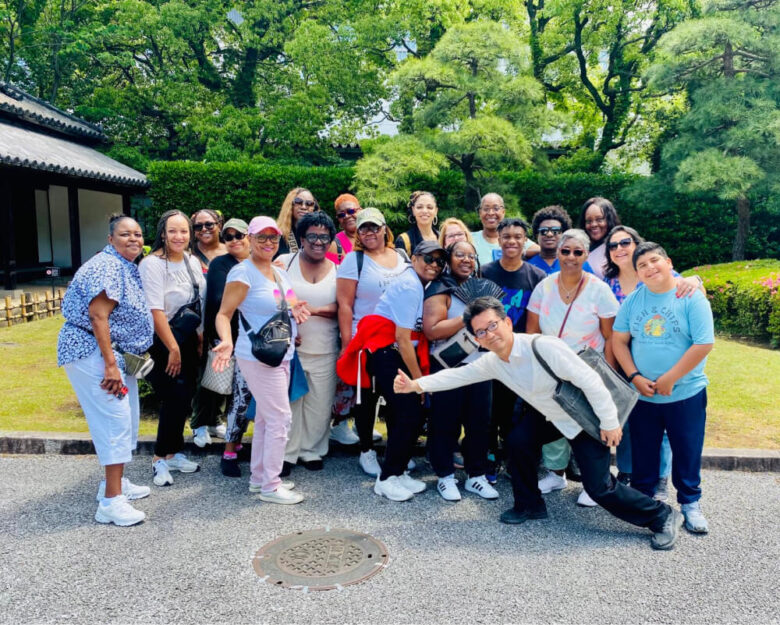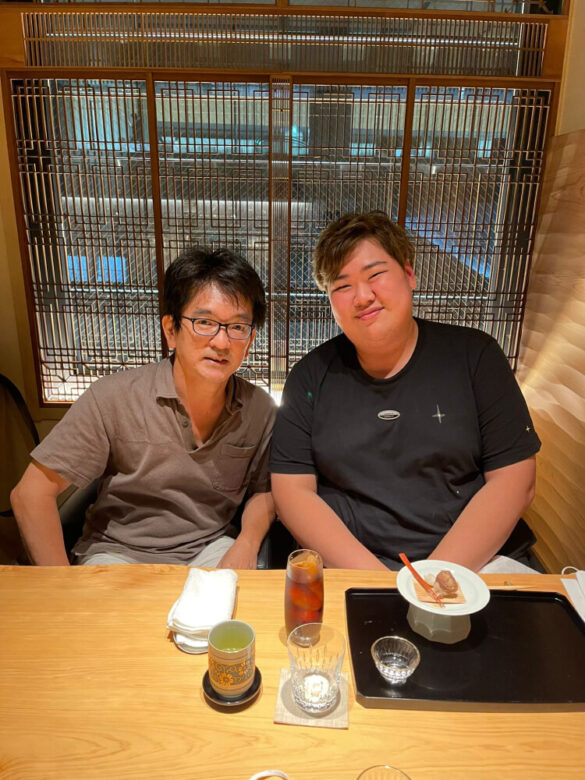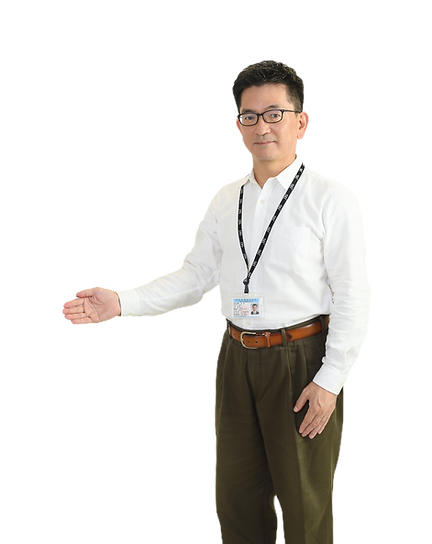PLANS
Not ready-made but a customized one for
a guest by guest.

Advantages of
Customized Tours
My tour is not a ready-made one, but a customized tour tailored to each guest. This offers an overwhelming advantage compared to large group tours with fixed itineraries. For example, we can flexibly adjust the course depending on the weather, which is almost impossible with large group tours. Don’t you think it’s nonsensical to climb Tokyo Skytree in heavy rain or walk long distances under the strong summer sun? Additionally, some guests may worry about keeping up with others due to age or physical condition, but with private tours, you can walk or rest at your own pace. Moreover, if you feel like taking a coffee break during the trip or have questions for the guide, you don’t have to hesitate in a private tour!
The Importance of
Communication
with Guests
To propose the best plan for my guests, I would like to start communication as early as possible and share their thoughts, concerns, wishes, and desires. The core of my guiding is a thorough and deep understanding of Japanese culture. I refine my plans based on guests’ wishes and experiences. If it’s a first visit to Tokyo, some places are indispensable for first-timers. If there is a seasonal event like cherry blossom viewing or a shrine festival, I will try to include it in the plan. As a result, my tour plan fits the guest’s demand, making the route and schedule efficient, and the tour becomes most attractive. Since time is most precious during travel, I believe it’s crucial to create a tailor-made plan for each guest.

Tell me your preference,
major tourist Spots or local Japanese style
In my contact form on this website, I asked if you would visit famous tourist spots or places local Japanese usually go. Below is my basic guiding policy on each of your choices.
Major tourist spots
The number of foreign tourists who visit Tokyo in 2019 was about 15 million. It was about half of the whole visitors to Japan. Therefore, many tourists feel like seeing as many famous places as possible, which is understandable.
As a tour guide in Tokyo, I have a few indispensable spots to visit for understanding Tokyo’s history. They are the Imperial Palace (ex. Edo castle), Meiji Jingu Shrine, and landscape-style Japanese gardens.
I will add some more places into my plan for customers who would like to visit significant destinations. Other options, for example, are places you can view over Tokyo (a Tokyo Skytree tower, Roppongi Hills Mori Tower, or Tokyo Metropolitan Government Building). When you are interested in pop/modern and contemporary culture, I will include Shibuya, Harajuku, or Akihabara. It is possible to visit all of them within a one-day tour, but I can propose a plan with more time to spare if you allow me to guide you for 2 or 3 days.
Local Japanese lifestyle
Some visitors like to avoid touristy places prefer to see ordinary Japanese life. In such a case, I will propose a tour at a slower pace and choose the spots like Kagurazaka or Azabu-Juban. Kagurazaka is my hometown, and you will know the roles of local shrines and temples. I will also show you an authentic tearoom where you can taste the green tea. It is not a place for tourists, but for local people to have a relaxing time with tea and sweets.
Another proposal is to visit towns local young people often go to on weekends. I want to propose Koenji and Shimokitazawa. Both towns aren’t really tourist destinations, but there are many shops selling vintage clothing, accessories, vinyl records, antiques, cozy cafes, etc., that give the town a unique ambiance. If you are tired of touristy places, these must be good choices.
Other Special Tours
I can guide outside of Tokyo, for example, Yokohama, Kamakura, Nikko, etc. I often pick you up or see you off at a Yokohama port where cruises arrive/start. Besides, I can cope with your request to organize a special tour. In the past, a guest wanted to visit as many used vinyl record shops in Tokyo as possible to hunt treasures. I made a list of the record shops region by region in Tokyo.
I called all of them in advance to confirm if they were really doing business. Another guest wanted to buy Ukiyo-e printings (woodblock prints), so I researched where they are available. He was delighted with what he purchased, and now the works decorated his house. I welcome any special request. Frankly speaking, I always enjoy the process of finding solutions for my guests together.
Playing Golf
If you are a golf enthusiast, wouldn’t you like to play golf in Japan? If so, we propose a one-day golf tour. We will take you to membership golf courses in the suburbs of Tokyo. We will pick you up at your hotel and drive you to the course. Upon request, we can also take you to the airport. Please note that this is a guided tour, so Ken Oka, your guide, will play with you. Also, the number of guests is limited to 3.
Please pay the playing fee by yourself.
Depending on the day of the week and the golf course, the playing fee is about 15,000 yen to 25,000 yen per person, transportation fee is about 10,000 yen per car, and the guide fee. Clubs can be rented at the golf course, but please bring your own shoes. Please consult with us individually for details.
VLOG
Watch our VLOG and you can see famous tourist spot!
I here with introduce some destinations in Tokyo. Some are major tourist spots, while some are towns mainly for local Japanese people. In any case, they are sure to help you understand Japanese history, culture, and life. I am willing to include these places in my tour plan designed for you. Please tell me if you are interested in any one of them.
The Imperial Palace East Garden
The Imperial Palace East garden was previously an Edo castle of Tokugawa Shogunate. It was the biggest and strongest castle in Japan. In the late 19th century, the castle was peacefully handed over to the new government led by Emperor Meiji, and became the Imperial Palace. This is the place where modern Japan started.
Meiji Jingu Shrine
It is a Shinto shrine where Emperor Meiji and Empress are enshrined. He is respected and loved by Japanese people because he successfully led Japan toward modernized country after the Meiji restoration 150 years ago. Once stepping in, You should feel spiritual tranquility in cool air.
Ueno Park & Toshogu Shrine
Original Toshogu locates in Nikko and is a world heritage, while Ueno Toshogu is in Ueno Park which is famous for cherry blossoms in spring, and easier to visit. Ueno Toshogu is also built in the mid of the 17th century to worship Tokugawa Ieyasu, the 1st Shogun, and a builder of Tokyo town.
Koishikawa Korakuen
(Japanese garden)
This is one of the most reputable Japanese landscape gardens made in the 17th century. At the time, there was a mansion of the Tokugawa Shogunate family in this important location. The garden has plum tree woods, spring water, a big pond and artificial mountains with ballpark as its backdrop now.
Kagurazaka
Kagurazaka is a compact town in the center of Tokyo. Because there were hundreds of Geisha houses in the peak period (only a few remain now, though) along narrow back alleyways with stone steps, it still holds the scent of traditional Japanese culture. The town offers an authentic Japanese tearoom as well.
Omotesando architecture tour
Omotesando is called the Champs-Elysees of Tokyo. One of the draws here are numerous buildings designed by the world’s famous architects along the street, which is rarely seen in other parts of the world. It’s a pavilion of modern architecture.


